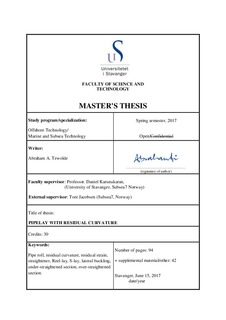| dc.contributor.advisor | Karunakaran, Daniel | |
| dc.contributor.advisor | Jakobsen, Tore | |
| dc.contributor.author | Tewolde, Abraham | |
| dc.coverage.spatial | Norway, Stavanger | nb_NO |
| dc.date.accessioned | 2017-10-20T06:45:23Z | |
| dc.date.available | 2017-10-20T06:45:23Z | |
| dc.date.issued | 2017-06-15 | |
| dc.identifier.uri | http://hdl.handle.net/11250/2461143 | |
| dc.description | Master's thesis in Offshore technology: Marine and subsea technology | nb_NO |
| dc.description.abstract | Offshore pipelines under operating loads, i.e. under high temperature and pressure, are exposed to expansion and compressive forces, which may cause the pipeline to buckle globally. If significant lateral motion and excessive feed-in occurs at a specific location, the pipeline may form a sharp twist of high curvature where the resulting strain may be very large to initiate structural failure.
Commonly used mitigation measures in the offshore industry are by continuous burial or rock damping to avoid buckling of the pipeline completely; and by using various methods to trigger lateral buckling in a controlled and effective manner at a relatively low axial compressive force, for example snake lay, artificial vertical imperfections & buoyancy modules. These mitigation measures require the implementation of additional methods on the seabed, which often appear with significant cost.
Recent developments have shown how the use of intermittent residual curvature sections during reel-lay installation of pipelines can be used to control global pipeline thermal buckling in the operational phase. The method was first implemented in Statoil’s Skuld project in the Norwegian sea in 2012. Results have shown that every section of the residual curvature is triggered as expected and ensured the sharing of thermal expansion. No additional methods were required to ensure the utilization within acceptable criteria. The method was found to be rewarding and cost effective than the above mentioned conventional mitigation methods.
The residual curvature sections are created as under-straightened sections in the vertical plane at the straightener of the reel-lay vessel. These convex upward residual sections create an additional imperfection in the pipeline and lead to pipe roll as it moves through the under-bend due to reversed bending. If the RCM is to be used effectively as a means for lateral buckling control, the residual curvature sections should acquire a position of stable equilibrium by ending the roll in the horizontal plane at the seabed. The tendency of the pipeline to bend and roll due to the residual curvature sections introduced on the reel ship can be estimated by energy approach. The total work done from the water surface to the seabed TDP is the sum of the bending and roll contribution. After initiating roll, the pipeline ends up in an equilibrium position when the total estimated work done is minimum and the corresponding angle gives the roll angle.
Considering the aspects discussed above, the current work focuses on an analytical energy approach method for the estimation of the total work done to bend and twist the pipeline from the surface to the seabed; and estimate pipeline roll at the seabed TDP. Sensitivity studies of various parameters are carried out based on single pipe sections of 12” ID & 14” ID as well as 18” OD pipe-in-pipe in water depth of 360m, 800m and 1200m. The thesis also includes a brief model of pipeline installation by introducing pre-bent curvature section using global analysis tool OrcaFlex. The purpose is to compare the results against the analytical method. | nb_NO |
| dc.language.iso | eng | nb_NO |
| dc.publisher | University of Stavanger, Norway | nb_NO |
| dc.relation.ispartofseries | Masteroppgave/UIS-TN-IKM/2017; | |
| dc.rights | Navngivelse 4.0 Internasjonal | * |
| dc.rights.uri | http://creativecommons.org/licenses/by/4.0/deed.no | * |
| dc.subject | offshore teknologi | nb_NO |
| dc.subject | undervannsteknologi | nb_NO |
| dc.subject | pipe roll | nb_NO |
| dc.subject | residual curvature | nb_NO |
| dc.subject | offshore technology | nb_NO |
| dc.title | Pipelay with Residual Curvature | nb_NO |
| dc.type | Master thesis | nb_NO |
| dc.subject.nsi | VDP::Teknologi: 500::Marin teknologi: 580::Offshoreteknologi: 581 | nb_NO |
| dc.source.pagenumber | 94 | nb_NO |

